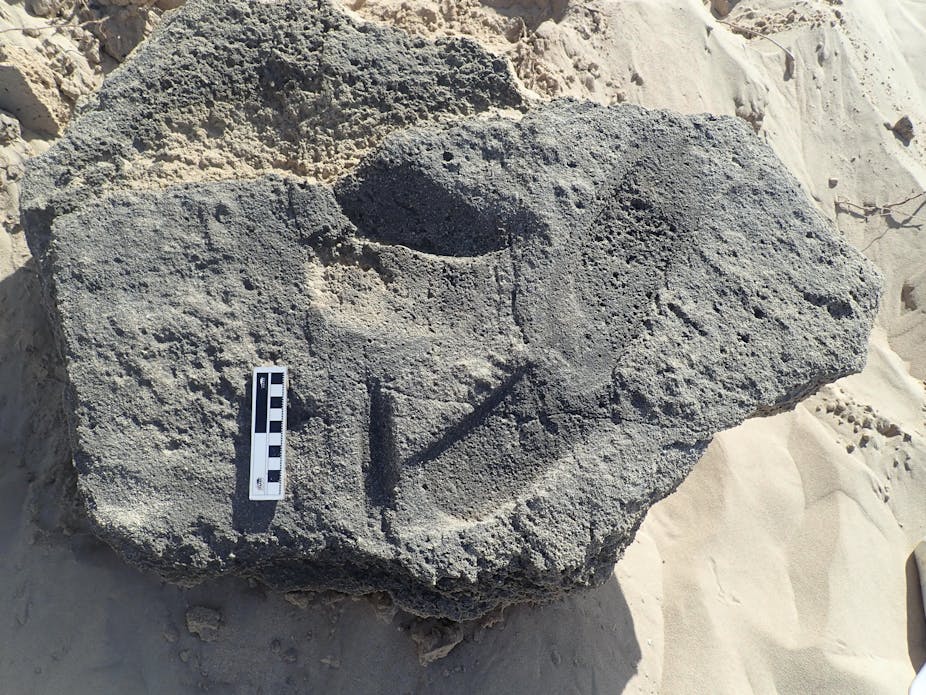When and where did our ancestors first fashion footwear? We cannot look to physical evidence of shoes for the answer, as the perishable materials from which they were made would no longer be evident. Ichnology, the study of fossil tracks and traces, can help to answer this unresolved question through a search for clear evidence of footprints made by humans who were shod – that is, wearing some kind of foot covering.
But this is no simple endeavour, as our research team from the Cape south coast ichnology project in South Africa recently reported. Over the past 15 years we have identified more than 350 vertebrate tracksites along the Cape coast. These include a number of tracks made by humans who were clearly walking or jogging barefoot, as evidenced by toe impressions. But we also noticed similar trackways, seemingly well preserved, that contained no toe impressions. Realising, too, that very little research has been done about when humans first fashioned footwear, we decided to investigate further.
To do so, we studied relevant research from various parts of the world, using our knowledge about milestones in human technological development such as when and where our ancestors had the technology to create bone tools which could have been used for sewing.
We also considered the areas where ancient hominin tracks have been reported. This revealed that there are two prime places on the planet to look for footprint evidence of early shod hominins: western Europe and the Cape coast of South Africa. We followed up with a little crafting of our own to create the types of footwear that might have been worn. Most of the tracksites we have found are between about 70,000 years and 150,000 years in age, so that is the time period we focused on.
Our findings, recently published in the journal Ichnos, suggest that there are at least three tracksites on the Cape south coast that might have been made by shod humans (a fourth site unfortunately rapidly deteriorated in quality and slumped into the sea). The global record of sites attributed to shod trackmakers is sparse. Until now, only four sites older than 30,000 years have been postulated, all from western Europe, including a Neanderthal site.
Though the evidence is not conclusive, we are excited about our discoveries. They support the notion of southern Africa being one region where human cognitive and practical ability developed a very long time ago.
The study
We considered the published studies on possible shod-human tracks from western Europe, and searched the Cape coast for similar sites. Today, the ancient dune surfaces our ancestors walked along are cemented and preserved as aeolianites. We have previously reported on the tracks of our barefoot Homo sapiens ancestors along this coastline and now focused on three sites which appeared to be of hominin origin and were crisply outlined, but contained no evidence of toe impressions.
Next, we drew on our knowledge of sandals used by the indigenous San people on the sands of the Kalahari desert to give us ideas about what ancient footwear might have looked like. After studying museum specimens, depictions of footwear in the San rock art record and the oldest surviving examples of footwear, it was time to do a little cobbling.
We crafted various types of footwear and used them to create trackways on the beaches and dunes of the Cape south coast; then we analysed them.
Read more: Graffiti threatens precious evidence of ancient life on South Africa's coast
From these experiments it became clear that an open, hard sole design, with tracks made on moist, moderately soft but nonetheless cohesive sand, best fitted the findings at the three fossil tracksites.
Preservation and clarity
Usually, to identify hominin tracks, the presence and alignment of toe impressions is a crucial factor. Clearly such features are unlikely to be present in the tracks of ancestral humans using footwear. We needed to ensure that the findings suggesting shod hominins were genuine rather than being due to poor preservation, or erosion, or that the tracks had simply been made in soft sand by barefoot humans.
Read more: World's oldest _Homo sapiens_ footprint identified on South Africa's Cape south coast
Crisp track margins therefore became an essential feature at our three sites. Tracks had to have an approximate hominin footprint outline. Strap attachment points, if they left marks in the tracks, formed a welcome bonus.
None of the three sites has been dated at this point, although nearby dated sites suggest that they range in age from around 70,000 years to more than 130,000 years old.
While our evidence is suggestive, we do not consider it conclusive as yet. We’re searching for further sites which ideally, in addition to displaying good preservation, would contain long trackways to allow for detailed analysis.
Why make footwear?
One obvious question stemming from this research is why our ancestors would have elected to create footwear, whereas up until that point they had survived barefoot.
Perhaps once they had developed the means to create complex clothing through bone tools, footwear might have been a logical addition. Anyone who has tried to forage on the Cape coast today knows how sharp some of the rocks are and how easy it is to suffer a laceration if not wearing shoes. In the Middle Stone Age, about 130,000 years ago, an infected laceration might well have been a death sentence.
Protection from extremes of heat and cold might also have been incentives, and the use of footwear might initially have been occasional or intermittent.

